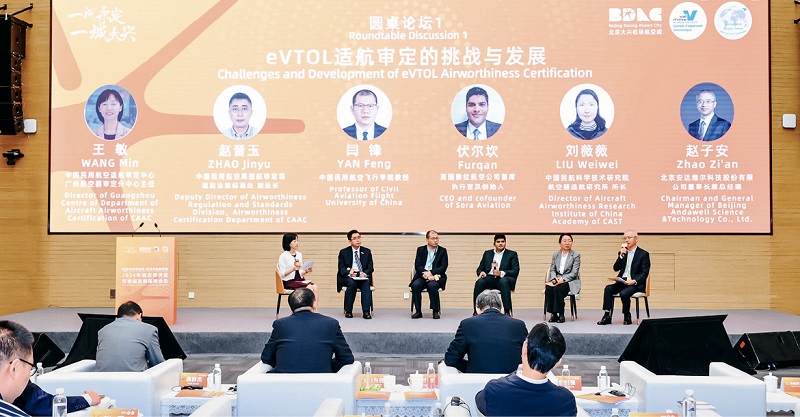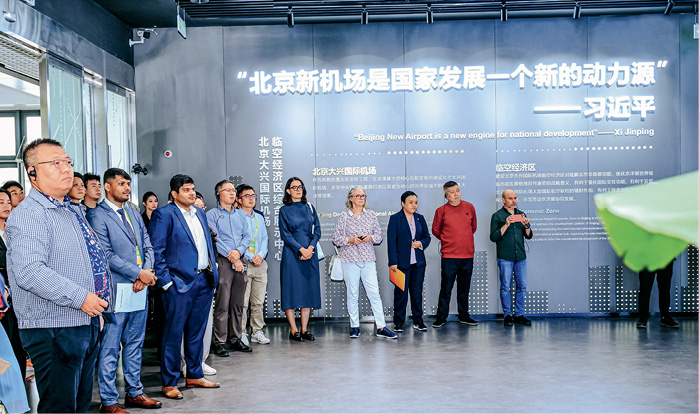
Maria Krylova (right, second), a senior counselor of Frankfurt Airport, visits the Beijing Institute of Aerospace Testing Technology with other experts in the aviation industry on September 27, 2024.
Did you ever imagine that one day you can hop into a flying taxi, just like in the sci-fi movies, hurtling among skyscrapers and cities?
On August 18, life took a closer step to fiction as a low-altitude passenger transport route opened, going from the Shanghai Pudong International Airport to the Kunshan City Terminal in neighboring Jiangsu Province. The trip, covering approximately 85 kilometers, took around 25 minutes.
One month later, on September 30, Beijing unveiled a plan to develop the low-altitude economy over the next three years. The vision is to nurture the sector as a key driver of coordinated development of the Beijing-Tianjin-Hebei region. The capital aims to become a hub for innovation in the low-altitude economy and a national demonstration zone. The goals include fostering over 5,000 related enterprises within three years, and an industry worth RMB 100 billion.
The applications include emergency rescuing, low-altitude logistics distribution in select districts, low-altitude passenger routes between the Daxing International Airport and Xiong’an New Area, where many administrative wings have been relocated, intercity air commuting, and cultural tourism. By 2027, more than 10 replicable application scenarios for low-altitude economy will be formed in Beijing.
The latest stimulus for this drive came from the third plenary session of the 20th Central Committee of the Communist Party of China in July, which adopted a resolution on deepening reform. In this document, the Party decides to build a comprehensive transportation system to develop general aviation and low-altitude economy.
Beijing’s urban mobility has undergone three major changes, said He Tianxing, vice-president of Guangzhou EHang Intelligent Technology Co., Ltd. From horse-drawn carriages to cars, and then to the subway, the changes diverted the city’s traffic layout from its central axis to the circling six ring roads, and then to the underground rail transit. “This is, in essence, a process of decentralization of transportation, and will resolve ground traffic congestion. We can imagine the bold future, with low-altitude aircraft flying over Beijing. It is not just a revolution in transportation, but also of people’s living environment,” said He.

A panel of domestic and foreign participants discuss eVTOL airworthiness certification at an international forum held in Beijing on September 26, 2024.
Europe Shares Its Dreams
On September 26, Beijing hosted an international forum on airworthiness and safe development of the low-altitude economy. The participants, who were from the aviation industry in China and Europe, discussed prospects across the globe, the electric vertical take-off and landing (eVTOL) aircraft and its role in urban air mobility (UAM).
August 11 was a red-letter day. On this day, Volocopter, the German aircraft manufacturer specializing in designing vehicles meant to be used as air taxis, conducted the world’s first eVTOL flight test. Early at dawn, its two-seater aircraft took off from the grounds of the iconic Versailles Palace. It was a fitting finale to the Paris Summer Olympics as it was the last day of the Games. Prior to this, Volocopter had successfully completed a crewed test flight at the nearby Saint-Cyr-l'École Airfield, the first bespoke commercial vertiport for eVTOLs.
The two flights validated eVTOL operations, a critical step to make electric flights a norm in the city and beyond. It is a phase of immense significance for the entire innovative air mobility (IAM) industry as it provided practical knowledge for integrating eVTOLs in vertiports and airspaces in megacities worldwide.
Interestingly, the vertiport at the Saint-Cyr-l'Ecole Airfield is built by Groupe ADP, the Paris-based international airport operator, which is also a longstanding partner of Velocopter. “With this flight, the partners begin their operational validation phase, a pre-commercial test series to mature the eVTOL ecosystem in France,” said Joyce Abou Moussa, a deputy director at Groupe ADP. “This includes flight maneuvers to and from the vertiport, ground handling, communication with air traffic control, and battery charging and management at vertiports.”
Groupe ADP has a unique position in Europe due to its integrated network of airports. It operates the three main airports in Paris – Charles de Gaulle, Orly, and Le Bourget, in addition to a network of airfields in the region including Paris Heliport.
Moussa said besides cities, advanced air mobility (AAM) – using next-generation remotely piloted, autonomous or eVTOL aircraft – is also being used in some remote and inaccessible regions, playing an increasingly important role in transporting personnel, medical care, and commercial resources. She expressed confidence in its future as AAM means zero-emission aviation by making aircraft electricity-powered and highly autonomous.
Maria Krylova, a senior counselor of Frankfurt Airport, talked about Lilium at the conference. Founded in 2014, Lilium Air Mobility, headquartered in Munich, Germany, has manufactured a jet for air taxi service, capable of carrying four to six passengers, or just for logistics services. Lilium is seeking the airworthiness certificate issued by the EU Aviation Safety Agency and the U.S. Federal Aviation Administration as well as from China.

Foreign experts visit an exhibition about the development of the Beijing Daxing International Airport on September 27, 2024.
The Subversive Potential
There is also collaboration cutting across borders. Eve Air Mobility is a prime example of that. It is a subsidiary of Embraer, the Brazilian aerospace corporation. The Sao Paulo-based company recently received a US $88 million loan from Brazil's state development bank BNDES for its first production facility.
Augustine Tai, head of business development for the APAC region at Eve, said its eVTOL aircraft has a cruising range of around 100 kilometers and can carry four to six passengers. The aircraft is completely electricity-driven and emits 80 percent less carbon dioxide compared with cars. It also minimizes noise by 90 percent compared with helicopters, and the commuting cost is less than one fifth of that of helicopters. “Its human-centered design ensures the safety, accessibility and comfort of passengers, the pilot and the community,” Tai said.
Compared with traditional aircraft, eVTOL generates less noise and is eco-friendly, economic, and comfortable. It has subversive potential in low-altitude transportation, logistics, sightseeing, medical first aid, and other scenarios, and is likely to have a trillion-dollar market and broad development prospects, becoming a new engine of social innovation and economic development.
At the conference, the UAM Working Committee of the Chinese Society of Aeronautics and Astronautics was formed. Zhu Tianzhu, assistant director of Management Committee of Beijing Daxing International Airport Economic Zone, said the committee will be a pool of intellectual resources and a professional platform to promote the low-altitude economy and UAM development.